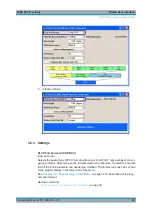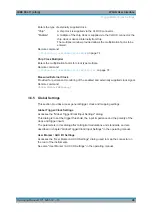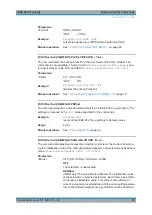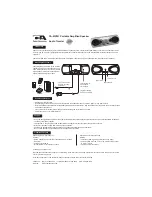
WLAN User Interface
IEEE 802.11 (a/b/g)
40
Operating Manual 1171.5283.12 ─ 18
With baseband clipping, all the levels are limited to a settable value (clipping Level).
This level is specified as a percentage of the highest peak value. Since clipping is done
prior to filtering, the procedure does not influence the spectrum. The EVM however
increases. Since clipping the signal not only changes the peak value but also the aver-
age value, the effect on the crest factor is unpredictable.
Remote command:
[:SOURce<hw>]:BB:WLAN:CLIPping:STATe
Clipping Level
Sets the limit for clipping.
This value indicates at what point the signal is clipped. It is specified as a percentage,
relative to the highest level. 100% indicates that clipping does not take place.
Remote command:
[:SOURce<hw>]:BB:WLAN:CLIPping:LEVel
Clipping Mode
Selects the clipping method. A graphic illustration of how the two methods work is
given in the menu.
"Vector | i + q
|"
The limit is related to the amplitude | i + q |. The I and Q components
are mapped together, the angle is retained.
"Scalar | i | + |
q |"
The limit is related to the absolute maximum of all the I and Q values |
i | + | q | .
The I and Q components are mapped separately, the angle changes.
Remote command:
[:SOURce<hw>]:BB:WLAN:CLIPping:MODE
3.6
Trigger/Marker/Clock Settings
To access this dialog, select "Main Menu > Trigger/Marker".
The "Trigger In" section is where the trigger for the signal is set. Various parameters
are provided for the settings, depending on which trigger source - internal or external -
is selected. The current status of signal generation ("Running" or "Stopped") is indica-
ted for all trigger modes.
Trigger/Marker/Clock Settings
















































